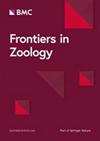通过公民科学驱动的图像库跟踪北美浣熊(Procyon lotor)种群的驯化信号
IF 2.6
2区 生物学
Q1 ZOOLOGY
引用次数: 0
摘要
北美浣熊广泛分布在美国各地,生活在离人类很近的地方(即城市)和农村环境中。这使它们成为研究人类环境对表型性状影响的比较工作的优秀物种。我们使用浣熊作为哺乳动物模型系统来测试暴露于人类环境是否会触发驯化综合征的特征。我们的数据表明,城市环境导致鼻部长度减少,这与驯化综合征表型一致。这些结果对于讨论神经嵴驯化综合征假说的有效性至关重要。它们还提供了新的机会,可以潜在地观察尚未驯化的哺乳动物物种的早期驯化模式,而不可能与其他已驯化的哺乳动物发生遗传渗入或杂交。本文章由计算机程序翻译,如有差异,请以英文原文为准。
Tracking domestication signals across populations of North American raccoons (Procyon lotor) via citizen science-driven image repositories
North American raccoons are widespread across the contiguous United States and live in close proximity to humans (i.e. urban) and in rural environments. This makes them an excellent species for comparative work on the effects of human environments on phenotypic traits. We use raccoons as a mammalian model system to test whether exposure to human environments triggers a trait of the domestication syndrome. Our data suggests that urban environments produce reductions in snout length, which are consistent with the domestication syndrome phenotype. These results are crucial for the discussion of the validity of the Neural Crest Domestication Syndrome hypothesis. They also offer new opportunities to potentially observe early-stage domestication patterns in a yet non-domesticated mammalian species, without the possibility of introgression or hybridization with other already domesticated mammals.
求助全文
通过发布文献求助,成功后即可免费获取论文全文。
去求助
来源期刊

Frontiers in Zoology
ZOOLOGY-
CiteScore
4.90
自引率
0.00%
发文量
29
审稿时长
>12 weeks
期刊介绍:
Frontiers in Zoology is an open access, peer-reviewed online journal publishing high quality research articles and reviews on all aspects of animal life.
As a biological discipline, zoology has one of the longest histories. Today it occasionally appears as though, due to the rapid expansion of life sciences, zoology has been replaced by more or less independent sub-disciplines amongst which exchange is often sparse. However, the recent advance of molecular methodology into "classical" fields of biology, and the development of theories that can explain phenomena on different levels of organisation, has led to a re-integration of zoological disciplines promoting a broader than usual approach to zoological questions. Zoology has re-emerged as an integrative discipline encompassing the most diverse aspects of animal life, from the level of the gene to the level of the ecosystem.
Frontiers in Zoology is the first open access journal focusing on zoology as a whole. It aims to represent and re-unite the various disciplines that look at animal life from different perspectives and at providing the basis for a comprehensive understanding of zoological phenomena on all levels of analysis. Frontiers in Zoology provides a unique opportunity to publish high quality research and reviews on zoological issues that will be internationally accessible to any reader at no cost.
The journal was initiated and is supported by the Deutsche Zoologische Gesellschaft, one of the largest national zoological societies with more than a century-long tradition in promoting high-level zoological research.
 求助内容:
求助内容: 应助结果提醒方式:
应助结果提醒方式:


